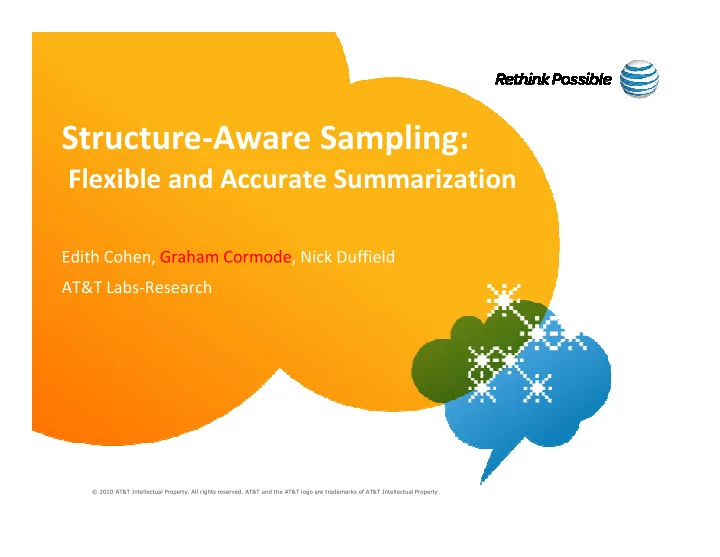

Structure-Aware Sampling: Flexible and Accurate Summarization Edith Cohen, Graham Cormode, Nick Duffield AT&T Labs-Research AT&T Labs-Research ����������������������������������������������������������������������������������������������������������������������������
���������������������� ♦ Approximate summaries are vital in managing large data E.g. sales records of a retailer; network activity for an ISP Need to store compact summaries for later analysis ♦ State-of-the-art summarization via sampling Widely deployed in many settings Widely deployed in many settings Models data as (key, weight) pairs General purpose summary, enables subset-sum queries Higher level analysis: quantiles, heavy hitters, other patterns & trends � ����������������������������������������������������������������������������������������������������������������������������
����������������������� ♦ Current sampling methods are structure oblivious But most queries are structure respecting! ♦ Most queries are actually range queries “How much traffic from region X to region Y between 2am and 4am?” ♦ Much structure in data ♦ Much structure in data Order (e.g. ordered timestamps, durations etc.) Hierarchy (e.g. geographic and network hierarchies) (Multidimensional) products of structures ♦ Can we make sampling structure-aware and improve accuracy? � ����������������������������������������������������������������������������������������������������������������������������
���������������������� ♦ Inclusion Probability Proportional to Size (IPPS): Given parameter τ , probability of sampling key with weight w is min{1, w/ τ } Key i has adjusted weight a i = w i /p τ (w i ) = max{ τ, w i } (Horvitz-Thompson) Can pick a τ so that expected sample size is k ♦ ♦ VarOpt sampling methods are Variance Optimal over keys: Produces a sample of size exactly k keys using IPPS probabilities Allow correlations between inclusion of keys (unlike Poisson sampling) Give strong tail bounds on estimates via H-T estimates But do not yet consider structure of keys � ����������������������������������������������������������������������������������������������������������������������������
������������������������� ♦ We define a probabilistic aggregate of sampling probabilities: Let vector p ∈ [0,1] n define sampling probabilities for n keys Probabilistic aggregation to p’ sets entries to 0 or 1 so that: � ∀ i. E[p’ i ] = p i (Agreement in expectation) � ∑ i p’ i = ∑ i p i (Agreement in sum) � ∀ key sets J. E[ ∏ i ∈ J p’ i ] ≤ ∏ i ∈ J p i ∀ ∏ ≤ ∏ (Inclusion bounds) � ∀ key sets J. E[ ∏ i ∈ J (1-p’ i )] ≤ ∏ i ∈ J (1-p i ) (Exclusion bounds) ♦ Apply probabilistic aggregation until all entries are set (0 or 1) The 1 entries define the contents of the sample This sample meets the requirements for a VarOpt sample � ����������������������������������������������������������������������������������������������������������������������������
���������������� ♦ Pair aggregation implements probabilistic aggregation Pick two keys, i and j, such that neither is 0 or 1 If p i + p j < 1, one of them gets set to 0: � Pick j to set to 0 with probability p i /(p i + p j ), or i with p j /(p i + p j ) � The other gets set to p i + p j (preserving sum of probabilities) If p i + p j ≥ 1, one of them gets set to 1: � Pick i with probability (1 - p j )/(2 - p i - p j ), or j with (1 - p i )/(2 - p i - p j ) � The other gets set to p i + p j - 1 (preserving sum of probabilities) This satisfies all requirements of probabilistic aggregation There is complete freedom to pick which pair to aggregate at each step � Use this to provide structure awareness by picking “close” pairs � ����������������������������������������������������������������������������������������������������������������������������
����������������� ♦ We want to measure the quality of a sample on structured data ♦ Define range discrepancy based on difference between number of keys sampled in a range, and the expected number Given a sample S, drawn according to a sample distribution p: Discrepancy of range R is ∆ (S, R) = abs(|S ∩ R| - ∑ i ∈ R p i ) Maximum range discrepancy maximizes over ranges and samples: Maximum range discrepancy maximizes over ranges and samples: Discrepancy over sample dbn Ω is ∆ = max s ∈ Ω max R ∈ � ∆ (S,R) Given range space � , seek sampling schemes with small discrepancy � ����������������������������������������������������������������������������������������������������������������������������
�������������������������� ♦ Can give very tight bounds for one-dimensional range structures ♦ � = Disjoint Ranges Pair selection picks pairs where both keys are in same range R Otherwise, pick any pair ♦ � = Hierarchy ♦ � = Hierarchy Pair selection picks pairs with lowest LCA ♦ In both cases, for any R ∈ � , |S ∩ R| ∈ { ∑ i ∈ R p i , ∑ i ∈ R p i } The maximum range discrepancy is optimal: ∆ < 1 � ����������������������������������������������������������������������������������������������������������������������������
��������������������� ♦ � = order (i.e. points lie on a line in 1D) Apply a left-to-right algorithm over the data in sorted order For first two keys with 0 < p i , p j < 1, apply pair aggregation Remember which key was not set, find next unset key, pair aggregate Continue right until all keys are set Continue right until all keys are set ♦ Sampling scheme for 1D order has discrepancy ∆ < 2 Analysis: view as a special case of hierarchy over all prefixes Any R ∈ � is the difference of 2 prefixes, so has ∆ < 2 ♦ This is tight: cannot give VarOpt distribution with ∆ < 2 For given ∆ , we can construct a worst case input � ����������������������������������������������������������������������������������������������������������������������������
������������������ ♦ More generally, we have multidimensional keys ♦ E.g. (timestamp, bytes) is product of hierarchy with order ♦ KDHierarchy approach partitions space into regions Make probability mass in each region approximately equal Use KD-trees to do this. For each dimension in turn: Use KD-trees to do this. For each dimension in turn: � If it is an ‘order’ dimension, use median to split keys � If it is a ‘hierarchy’, find the split that minimizes the size difference � Recurse over left and right branches until we reach leaves �� ����������������������������������������������������������������������������������������������������������������������������
Recommend
More recommend